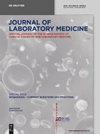Circulating pyridoxal 5′-phosphate in serum and whole blood: implications for assessment of vitamin B6 status
IF 1.1
4区 医学
Q4 MEDICAL LABORATORY TECHNOLOGY
引用次数: 0
Abstract
Abstract Objectives Concentrations of pyridoxal 5′-phosphate (PLP) in serum and whole blood are routinely measured. The suitability of these markers in capturing vitamin B6 insufficiency is not well studied. Methods In 212 subjects, concentrations of PLP and thiamine pyrophosphate (TPP) were simultaneously measured in EDTA-whole blood using Chromsystems® (52052) method on HPLC devices. The whole blood PLP concentrations were compared to serum PLP concentrations measured using reagents from Immundiagnostik® (KC 2100). The whole blood TPP concentrations measured with the Chromsystems® (52052) were compared to those measured by the Chromsystems® (35000) method. Concentrations of homocysteine (tHcy) and cystathionine (Cys) were measured and used to judge the PLP methods. Results Serum PLP concentrations were on average 41% lower than whole blood PLP [mean (SD)=55.4 (83.0) vs. 131 (217) nmol/L]. Serum and whole blood PLP showed a strong correlation [Pearson correlation coefficient=0.724, p<0.001, n=204]. Eighty-five samples showed discrepant results for PLP status (serum PLP ≤30 nmol/L, but whole blood PLP >51 nmol/L) while 102 samples showed coherent results (reference group). The discrepancy group showed higher odds ratio for elevated tHcy >12.0 μmol/L compared to the reference group [OR (95% confidence intervals, CI)=2.1 (1.2–4.0)]. The OR (95% CI) of elevated Cys >300 nmol/L was 1.9 (1.0–3.5) in the discrepancy group compared to the reference group. TPP concentrations were 6% lower when using the Chromsystems®, 52052 compared to levels measured with Chromsystems®, 35000. Conclusions Serum and whole blood PLP concentrations disagree in a substantial number of samples. Serum PLP was better in reflecting elevated tHcy and Cys compared to whole blood PLP. Whole blood PLP underestimates the prevalence of vitamin B6 insufficiency. Methods of measuring TPP concentrations in whole blood were exchangeable.血清和全血中循环的5′-磷酸吡哆醛:对评估维生素B6状态的意义
摘要目的常规测定血清和全血中5′-磷酸吡哆醛(PLP)的浓度。这些标志物在捕捉维生素B6缺乏方面的适用性还没有得到很好的研究。方法采用Chromsystems®(52052)方法在高效液相色谱装置上同时测定212例受试者EDTA全血中PLP和焦磷酸硫胺素(TPP)的浓度。将全血PLP浓度与使用Immundiagnostik®(KC 2100)试剂测量的血清PLP浓度进行比较。将用Chromsystems®(52052)测得的全血TPP浓度与用Chromsystems®(35000)法测得的TPP浓度进行比较。测定同型半胱氨酸(tHcy)和胱硫醚(Cys)的浓度,并用于判断PLP方法。结果血清PLP浓度平均比全血PLP低41%[平均值(SD)=55.4(83.0)vs.131(217)nmol/L]。血清和全血PLP显示出很强的相关性[Pearson相关系数=0.724,p51nmol/L),而102个样本显示出一致的结果(参考组)。与参考组相比,差异组显示tHcy升高>12.0μmol/L的比值比更高[OR(95%置信区间,CI)=2.1(1.2-4.0)]。Cys升高>300nmol/L的OR(95%CI)为1.9(1.0-3.5)差异组与参考组的比较。使用Chromsystems®52052时,TPP浓度比使用Chromsystems®35000测量的水平低6%。结论大量样本的血清和全血PLP浓度不一致。与全血PLP相比,血清PLP更好地反映tHcy和Cys的升高。全血PLP低估了维生素B6缺乏的患病率。全血中TPP浓度的测量方法是可交换的。
本文章由计算机程序翻译,如有差异,请以英文原文为准。
求助全文
约1分钟内获得全文
求助全文
来源期刊

Journal of Laboratory Medicine
Mathematics-Discrete Mathematics and Combinatorics
CiteScore
2.50
自引率
0.00%
发文量
39
审稿时长
10 weeks
期刊介绍:
The Journal of Laboratory Medicine (JLM) is a bi-monthly published journal that reports on the latest developments in laboratory medicine. Particular focus is placed on the diagnostic aspects of the clinical laboratory, although technical, regulatory, and educational topics are equally covered. The Journal specializes in the publication of high-standard, competent and timely review articles on clinical, methodological and pathogenic aspects of modern laboratory diagnostics. These reviews are critically reviewed by expert reviewers and JLM’s Associate Editors who are specialists in the various subdisciplines of laboratory medicine. In addition, JLM publishes original research articles, case reports, point/counterpoint articles and letters to the editor, all of which are peer reviewed by at least two experts in the field.
 求助内容:
求助内容: 应助结果提醒方式:
应助结果提醒方式:


